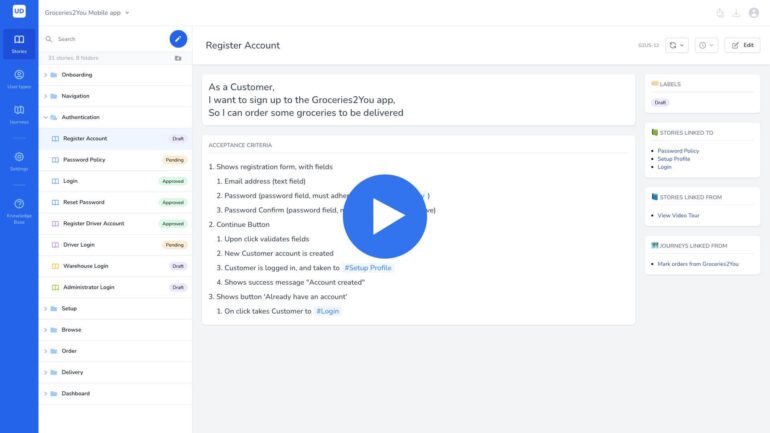TL;DR:
- Userdoc, a startup, introduces AI-driven software requirement generation.
- AI assistance improves requirement accuracy and identifies potential issues.
- Business context customization enhances software development governance.
- Userdoc distinguishes itself from ChatGPT with its business-focused approach.
- Complex projects with numerous features benefit from Userdoc’s support.
- The platform simplifies project setup and integrates with project management tools.
- Userdoc serves as a valuable reference point for developers and designers.
- Chris Rickard developed a custom communication layer for GPT-4 integration.
- Userdoc envisions expanding into compliance-related areas for future growth.
Main AI News:
In the rapidly evolving landscape of software development, the integration of artificial intelligence tools has become indispensable. While AI coding tools have become a staple in this domain, generative AI is now venturing into other facets of a developer’s workflow. One such innovative solution is Userdoc, a startup dedicated to revolutionizing the creation of software requirements through AI assistance. At the recent AI Engineer Summit held in San Francisco, we had the privilege of sitting down with Userdoc’s co-founder and lead developer, Chris Rickard, to delve into the inception of Userdoc and understand how it is poised to empower developers.
Requirements: The Cornerstone of Software Development
In any software development project, defining clear and comprehensive requirements is the foundational step. Chris Rickard underscores the pivotal role of robust requirements in delivering exceptional software solutions. He remarks, “A substantial part of crafting superior software lies in formulating precise requirements that align with the needs of the end-users. I was deeply intrigued by the potential of AI in streamlining this process, ensuring that potential issues are caught early on, averting the emergence of bugs, and preventing the unnecessary incorporation of superfluous features that fail to address the core problem.“
Harnessing the Power of AI for Requirements Generation
Userdoc’s novel approach to requirements generation harnesses the capabilities of AI, allowing it to be finely tuned to the specifics of a business. By priming the AI with contextual information about the business, Userdoc enables developers to build software with an inherent understanding of the broader implications. Rickard illustrates this by presenting an example where Userdoc aids in constructing requirements for a grocery delivery service, effectively acting as a “governance” mechanism for developers.
Distinguishing Userdoc from ChatGPT
While ChatGPT and Userdoc both leverage AI, Rickard distinguishes Userdoc by highlighting the significance of business context. He points out the potential risk associated with ChatGPT, which may “fabricate” information. Userdoc, on the other hand, utilizes the formidable GPT-4 underpinning but supplements it with a rich business context. To achieve a comparable outcome with ChatGPT, one would necessitate constructing an extensive prompt.
Tackling Complex Software Landscapes
In the realm of Userdoc projects, complexity often arises from a multitude of “user stories” that correlate with the numerous features within a software product. This complexity presents a significant challenge. As Rickard notes, “One of the prominent pain points we aim to address is the complexity that arises when a system encompasses a myriad of features. Failure to address these intricacies upfront frequently leads to software overruns and increased costs.“
Unveiling the Userdoc Workflow
The Userdoc platform streamlines the process of initiating a new project through a user-friendly wizard. This setup phase typically involves product owners, product managers, and business analysts, who define the users and their respective objectives. Subsequently, the project is transitioned to the developers. However, Rickard emphasizes that Userdoc also provides direct support to developers. It facilitates synchronization with popular project management tools like Jira and Azure DevOps, ensuring seamless tracking of feature progress.
Userdoc: A Valuable Reference Point
Userdoc’s utility extends beyond the initial project setup. In cases where software developers and designers are engaged in concurrent projects, Userdoc serves as a valuable reference point, especially when returning to a project after an extended period. Rickard emphasizes that the information within Userdoc can also serve as “long-term living documentation” for the system, offering a reliable source of truth about the software.
Exploring AI Tools in the AI Engineering Space
Given the context of the AI Engineer Summit, we couldn’t resist inquiring about Rickard’s adoption of cutting-edge AI tools. In response, he shared insights into his experimentation with LangChain, particularly in conjunction with OpenAI’s LLM. However, he ultimately opted to develop his own communication layer for interfacing with GPT-4. This decision enabled him to gain a deeper understanding of the underlying processes, ensuring seamless integration with Userdoc.
The Expanding Horizons of Userdoc
As Userdoc continues to evolve, the question arises: can it extend its influence beyond being a documentation source and power customer-facing chatbots? Rickard envisions this possibility, emphasizing the importance of distinguishing between internal and external knowledge. While Userdoc is currently self-funded, Rickard’s aspirations lean towards delving into the less explored territory of compliance rather than following the conventional path of creating consumer-facing chatbots for websites or apps. He envisions Userdoc contributing to the assurance that the business’s agreements align with the final product, potentially using AI to augment the testing process.
Conclusion:
Userdoc emerges as a trailblazing solution in the realm of software requirements generation, driven by the power of AI. Its ability to infuse business context into the development process, facilitate intricate project management, and serve as a dependable reference point positions it as a game-changer in modern software development. As the AI landscape continues to evolve, Userdoc’s potential for growth and innovation remains boundless, promising to redefine the way we approach software development.

